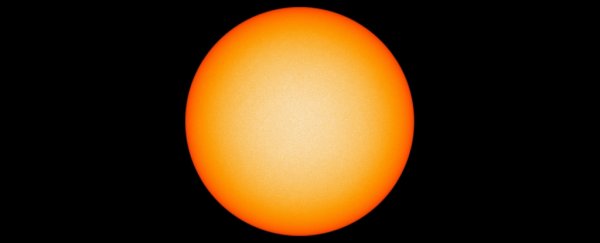Because we are normal people living in normal times, normal things are happening. Like news tabloids reporting that the Sun is in "lockdown", and that Earth is doomed to crazy weather famine and… earthquakes, for some reason.
Well, you can relax. Nothing the Sun is currently doing is going to create freezing weather, famine, or earthquakes. While humans are experiencing things that are decidedly not okay, the Sun is doing nothing unusual whatsoever.
What could be happening is a very normal period in the Sun's 11-year cycle; it's called solar minimum. And it's nothing to be afraid of - if you're reading this, chances are you've already lived through several solar minimums without even noticing.
Currently, we're in solar cycle 24. We don't know precisely when the next solar minimum will occur, but we can broadly predict it. Back in 2017, NASA noted that solar minimum was expected in 2019-2020.
In December of last year, the NOAA's Solar Cycle 25 Prediction Panel narrowed it down further, stating that "solar minimum between cycles 24 and 25 will occur in April, 2020 (+/- 6 months)."
So, we're either going through solar minimum already, or are just about to do so. Here's what that actually entails.
The solar cycle is based on the Sun's magnetic field, which flips around every 11 years, with its north and south magnetic poles switching places. It's not known what drives these cycles – recent research suggests it has to do with an 11.07-year planetary alignment – but the poles switch when the polar magnetic field is at its weakest; this occurs near the solar maximum.
Because the Sun's magnetic field controls solar activity – sunspots, coronal mass ejections and solar flares – the cycle is detectable to us as that activity changes. During solar minimum, there are, well, minimal sunspots and flares.
This gradually changes as the Sun ramps up to solar maximum. The magnetic field grows stronger, and sunspot and flare activity increases, before subsiding again for the next solar minimum.
The solar cycles aren't generally noticeable here on Earth. We may see more aurora activity during solar maximum, since auroras are generated by solar activity. Increased solar activity can also affect radio communications, and navigation satellites. People closely observing the Sun will see more sunspots during solar maximum.
At solar minimum, solar ultraviolet radiation decreases, but the effect of this primarily hits the stratosphere and higher altitudes. It causes Earth's atmosphere to shrink slightly, which reduces drag on satellites. Conversely, the increase in UV radiation during solar maximum contributes to rainfall, but the effect on temperature is negligible.
There is also an increase in galactic cosmic rays from sources such as supernovae during solar minimum. Earth's atmosphere protects us surface-dwellers from this radiation, which can increase the risk of cancer, but at higher altitudes the radiation does pose an additional hazard to astronauts.
"During solar minimum, the Sun's magnetic field weakens and provides less shielding from these cosmic rays," said astronomer Dean Pesnell of NASA's Goddard Space Flight Center in 2017. "This can pose an increased threat to astronauts traveling through space."
The link to dropping temperatures, earthquakes and famine is tenuous at best. A few days ago, a tabloid called, uh, The Sun cited unnamed "NASA scientists" fearing a repeat of an event known as the Dalton Minimum.
This occurred around the early 19th century, which saw an extreme period in Earth's recorded history, centred around 1816 - the Year Without a Summer. Temperatures dropped, crops failed, and many people around the world starved to death, or died from the cold.
Except that had nothing to do with the Sun's activity. All those problems were caused by the colossal 1815 eruption of Mount Tambora in Indonesia. In addition, a 2013 paper found no link between solar activity and earthquakes.
The most recent solar cycle was relatively quiet, leading to a lot of fearmongering over an impending Grand Solar Minimum, a longer period of time spanning several cycles where even the maximums are subdued. Reports suggested global temperatures would plummet, producing a mini ice age. NASA gave this idea a sound drubbing earlier this year.
"The warming caused by the greenhouse gas emissions from the human burning of fossil fuels is six times greater than the possible decades-long cooling from a prolonged Grand Solar Minimum," wrote the NASA Global Climate Change team in February.
"Even if a Grand Solar Minimum were to last a century, global temperatures would continue to warm. Because more factors than just variations in the Sun's output change global temperatures on Earth, the most dominant of those today being the warming coming from human-induced greenhouse gas emissions."
Some scientists have drawn a connection between solar minimum and volcanic activity, but it's weak and different papers don't agree on the periodicity. But we probably don't have to worry about that, either. The Sun is significantly more active than it was during the Dalton Minimum, which saw very low sunspot activity from around 1790 to 1830.
And, although cycle 24 was smaller than the previous few cycles, those cycles were unusually strong. Cycle 24 marked a return to a more normal activity level.
So, the solar minimum we're about to enter doesn't look particularly unusual, according to the NOAA and NASA, and we can expect a similar intensity to the previous cycle, they noted in their prediction.
